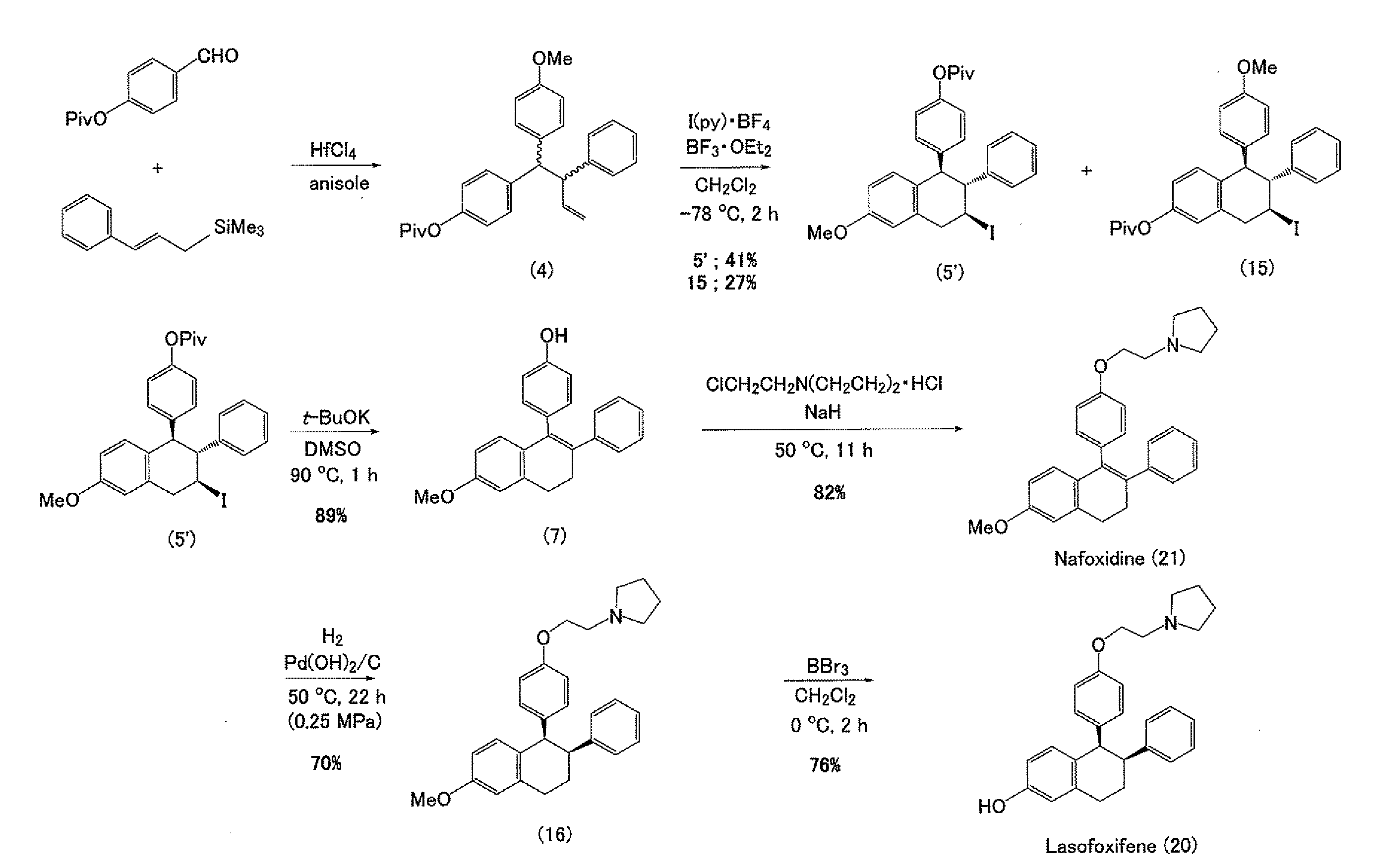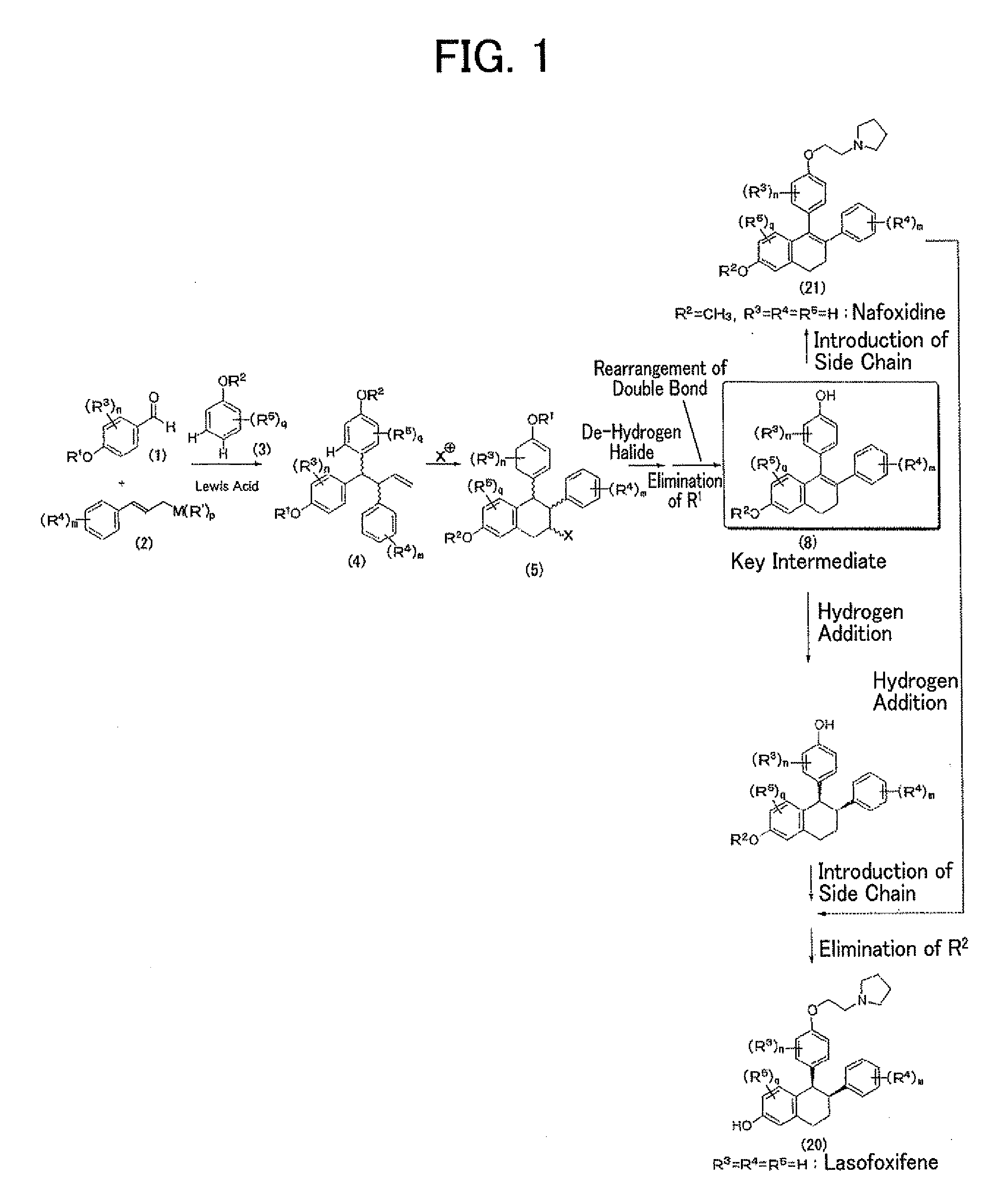Process for Production of Lasofoxifene or Analogue Thereof
- Summary
- Abstract
- Description
- Claims
- Application Information
AI Technical Summary
Benefits of technology
Problems solved by technology
Method used
Image
Examples
example 1
Construction of Triarylbutene Skeleton by Three-Component Coupling Reaction
1-(4-methoxyphenyl)-2-phenyl-1-(4-pivaloyloxyphenyl)-3-butene
[0068]
[0069]Hafnium chloride (39.2 mg, 0.122 mmol) was suspended in anisole (3, 0.02 mL) under an argon atmosphere, and then an anisole solution (0.22 mL) of 4-(pivaloyloxy)benzaldehyde (1, 25 mg, 0.121 mmol) and trimethyl cinnamylsilane (2, 46.7 mg, 0.245 mmol) was slowly added dropwise thereto under cooling by ice. The reaction mixture was stirred overnight at room temperature, then a saturated aqueous sodium bicarbonate solution (5 mL) was poured thereto, and the mixture was intensively stirred and extracted by adding diethyl ether (10 mL). The reaction mixture was further extracted two times using diethyl ether (10 mL), and then an organic layer was collected and rinsed with a saturated aqueous sodium chloride solution (5 mL), followed by drying with anhydrous magnesium sulfate and concentration thereof. The residue was purified by thin layer ch...
example 2
Construction of Tetrahydronaphthalene Skeleton by Cyclization Reaction
[0073]
[0074]Bis(pyridine)iodonium tetrafluoroborate (65.8 mg, 0.177 mmol) was suspended in methylene chloride (3.4 mL), and the suspension was cooled to −78° C. in a dry ice / acetone bath. A methylene chloride (1.8 mL) solution of 1-(4-methoxyphenyl)-2-phenyl-1-(4-pivaloyloxyphenyl)-3-butene (4, 56.0 mg, 0.135 mmol) was added to the suspension, and also a tribromoborane diethyl ether complex (0.015 mL, 0.118 mmol) was added stepwise three times. Thereafter, the reactant was stirred at −78° C. for 1 hour, then a saturated aqueous ammonium chloride solution (5 mL) was added thereto to stop the reaction, and the reactant was cooled to room temperature and then extracted three times with diethyl ether (10 mL). An organic layer was collected and rinsed with a saturated aqueous sodium chloride solution (10 mL), followed by drying with anhydrous sodium sulfate and concentrating. The residue was purified by thin layer chro...
example 3
Construction of Dihydronaphthalene Skeleton by De-Hydrogen Halide Reaction
7-methoxy-3-phenyl-4-(4-pivaloyloxyphenyl)-3,4-dihydronaphthalene (6)
[0078]
[0079]2-Iodo-7-methoxy-3-phenyl-4-(4-pivaloyloxyphenyl)-1,2,3,4-tetrahydronaphthalene (5, 39.4 mg, 0.0729 mmol) was dissolved in toluene (1.5 mL), then 1,8-diazabicyclo[5.4.0]undecene-7 (DBU, 0.035 mL, 0.234 mmol) was added thereto, and the mixture was stirred for 15 minutes while heating at 80° C. After allowing cooling, a saturated aqueous ammonium chloride solution (10 mL) was added under cooling by ice, and then the mixture was intensively stirred and extracted by adding ether (10 mL). The reaction mixture was further extracted two times using ether (10 mL), and then an organic layer was collected and rinsed with a saturated aqueous sodium chloride solution, followed by drying with anhydrous magnesium sulfate and concentration thereof. The residue was purified by thin layer chromatography (benzene / hexane=10 / 1) to obtain the title co...
PUM
 Login to View More
Login to View More Abstract
Description
Claims
Application Information
 Login to View More
Login to View More - R&D
- Intellectual Property
- Life Sciences
- Materials
- Tech Scout
- Unparalleled Data Quality
- Higher Quality Content
- 60% Fewer Hallucinations
Browse by: Latest US Patents, China's latest patents, Technical Efficacy Thesaurus, Application Domain, Technology Topic, Popular Technical Reports.
© 2025 PatSnap. All rights reserved.Legal|Privacy policy|Modern Slavery Act Transparency Statement|Sitemap|About US| Contact US: help@patsnap.com



